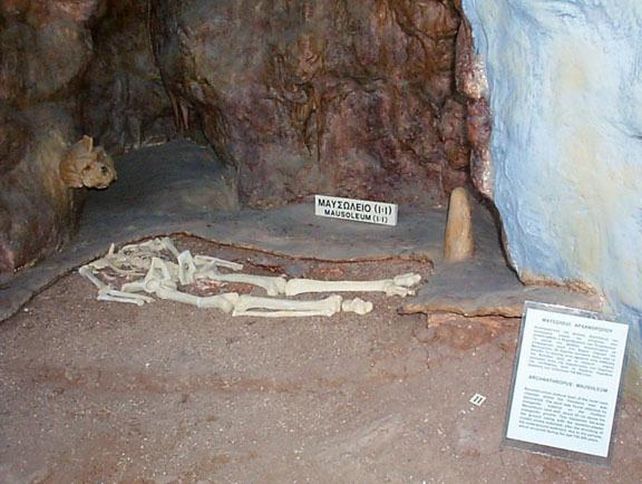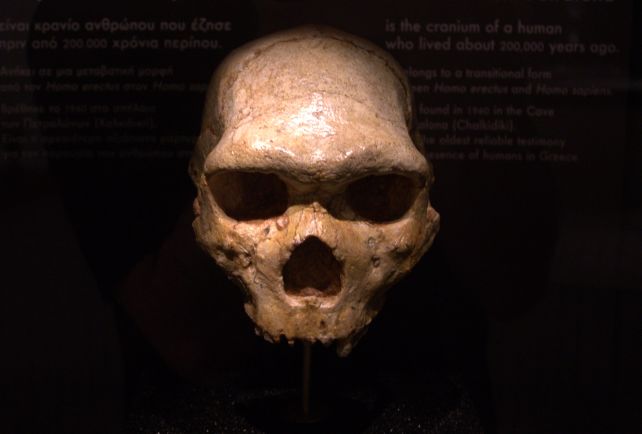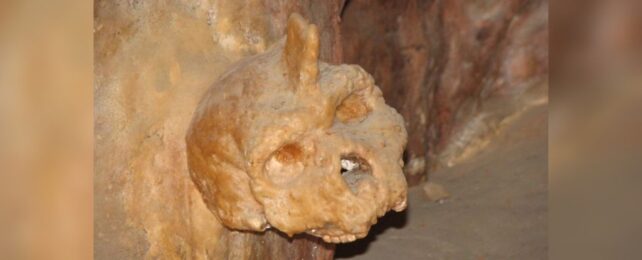A skull that was found embedded in a cave wall in Greece more than 60 years ago may finally have an identification.
A new dating of the minerals that surrounded and grew over the mysterious Petralona skull places its age at 277,000 years at least – and suggesting it is a member of a primitive, extinct hominid that lived alongside Homo neanderthalensis.
"From a morphological point of view," writes a team led by geochronologist Christophe Falguères of the Institute Of Human Paleontology in France, "the Petralona hominin forms part of a distinct and more primitive group than Homo sapiens and Neanderthals, and the new age estimate provides further support for the coexistence of this population alongside the evolving Neanderthal lineage in the later Middle Pleistocene of Europe."
Related: Ancient Egyptian Skull Found Riddled With Tiny Cut Marks. This Could Be Why.

The Petralona skull was uncovered in 1960 in Petralona Cave, not far from Thessaloniki in Greece. In the protected darkness of the inner chamber, the skull had been fused to the wall by a gradual accretion of calcite – a stalagmite protruding, unicorn-like, from its forehead.
Although the lower jaw was missing, this method of preservation had protected the cranium for what seemed to be many millennia, giving paleontologists an intact specimen to study – but a specimen of what, they couldn't agree.
Attempts at dating the skull placed its age anywhere between 170,000 and 700,000 years, and analyses of its structure and shape had it placed as Homo sapiens, Homo neanderthalensis, or Homo heidelbergensis, depending who was doing the work.
These are questions that have never quite been fully resolved. Falguères and his team thought the minerals of the cave might have some answers. In their new research effort, they have conducted a detailed dating analysis, and examined the previous 45 years of data currently available on the cave and the skull.

Their work involved a precision technique called uranium-thorium dating, which is possible thanks to the specific conditions that can be found in caves. Water seeps through the rock and drips down, depositing any minerals inside it as it goes. Over time, this creates layers upon layers of calcite, eventually building deposits called speleotherms, which include stalagmites and stalactites.
When speleotherms form, they sequester tiny amounts of radioactive uranium locked inside. Over time, that uranium decays into thorium at a very precise rate.
We also know that any thorium in the speleotherm has to be the product of uranium decay, because thorium isn't water soluble, but uranium is – so there could have been no thorium in the water that deposited the minerals. So, scientists can then look at the ratio of uranium to thorium in a sample, and determine exactly how old it is, based on the uranium decay rate.
Falguères and his colleagues used this technique to date the calcite that formed directly onto the skull – the first film of calcite directly over the bone. They also dated three samples taken from separate samples on the cave wall, with the oldest deposit being 539,000 years old.
If the skull was in direct contact with the cave wall from the beginning, it would be between 277,000 and 539,000 years old. If the skull was not originally attached to the wall but deposited there later, it would be between 277,000 and 410,000 years old.
The anatomy of the skull is distinct from both Homo sapiens and Neanderthals, which leaves open the tantalizing possibility that the Petralona skull belonged to a Homo heidelbergensis individual, a species whose place in the hominid family tree remains under debate.
The skull bears some striking similarities to a skull found in a cave in Kabwe, Zambia. The Kabwe skull has been dated to around 300,000 years ago, and is now generally classified as Homo heidelbergensis. This could help identify the Petralona skull in future work.
"Our results from dating the matrix attached to the Petralona cranium suggest that like the Kabwe cranium, the Petralona cranium may date to about 300,000 years ago, consistent with their persistence into the later Middle Pleistocene," the researchers write.
The paper has been published in the Journal of Human Evolution.
